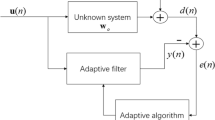Abstract
In this work a general exact methodology for capture effect and performance evaluation of packet radio networks is presented. Both narrow-band and spread-spectrum systems are investigated and compared. Several network performance quality indexes are considered: throughput, outage probability, packet error probability, average delay time. Two particular capture effect models are investigated. It can be seen that one of the two models can be considered as a good approximation of the other if a appropriate parameter definition is made. By using this methodology various operating conditions given by fading (Rice, Rayleigh, Nakagami), shadowing, different traffic models, different modulation, and coding schemes are investigated. Comparison is performed by means of spectral efficiency parity.
Similar content being viewed by others
References
S. Nanda, D. J. Goodman, and U. Timor, Performance of PRMA: a packet voice protocol for cellular systems,IEEE Trans. Vehicular Technology, Vol. 40, No. 3, 1991.
M. Zorzi and S. Pupolin, Slotted ALOHA for high-capacity voice cellular communications,IEEE Trans. Vehicular Technology, Vol. 43, No. 4, 1994.
O. Andriasano, D. Dardari, and R. Verdone, Code division and time division multiple access networks for vehicle-to-vehicle communications at 60 GHz,IEEE Vehicular Technology Conference, Stockholm, 1994.
W. Kremeret al., Computer-aided design and evaluation of mobile radio local area networks in RTI/IVHS environments,IEEE J.S.A.C., Vol. 11, No. 3, 1993.
J. C. Arnbak and W. Blitterswijk, Capacity of slotted Aloha in Rayleigh-fading channels,J.S.A.C., Vol. SAC-5, No. 2, 1987.
I. Habbab, M. Kavehrad, and C. Sundberg, Aloha with capture over slow and fast fading radio channels with coding and diversity,J.S.A.C., Vol. 7, No. 1, 1989.
J. Linnartz, R. Hekmat, and R. Venema, Near-far effects in land mobile random access networks with narrow-band Rayleigh fading channels,IEEE Trans. Vehicular Technology, Vol. 41, No. 1, 1992.
A. Sheikh, Y. Yao, and S. Cheng, Throughput enhancement of direct-sequence spread spectrum packet radio networks by adaptive power control,IEEE Trans. Communications, Vol. 42, No. 2/3/4, 1994.
U. H. Sheikh, Yao, and Wu, The Aloha system in shadowed mobile radio channels with slow or fast fading,IEEE Trans. Vehicular Technology, Vol. 39, No. 4, 1990.
I. Widipangestu, A. Jong, and R. Prasad, Capture probability and throughput analysis of slotted ALOHA and unslotted npISMA in a Rician/Rayleigh environment,IEEE Trans. Vehicular Technology, Vol. 43, No. 3, 1994.
N. Abramson,Multiple Access Communications, IEEE Press, New York, 1993.
N. Abramson, The throughput of packet broadcasting channels,IEEE Trans. Communications, Vol. 25, No. 1, 1977.
L. Roberts, Aloha packet system with and without slots of capture,Computer Communications Review, Vol. 5, No. 2, 1975.
J. Roberts and T. Healy, Packet radio performance over Rayleigh fading channels,IEEE Trans. Communications, Vol. 28, No. 2, 1980.
K. Zhang and K. Pahlavan, Relation between transmission and throughput of slotted ALOHA local packet radio networks,IEEE Trans. Communications, Vol. 40, No. 3, 1992.
R. Robertson and T. Ha, A model for local/mobile radio communications with correct packet capture,IEEE Trans. Communications, Vol. 40, No. 4, 1992.
M. Pursley, The role of spread spectrum in packet radio network,Proc. IEEE, Vol. 75, No. 1, 1987.
A. Polydoros, Slotted random access spread-spectrum networks: An analytical framework,IEEE J.S.A.C., Vol. 5, No. 6, 1987.
Y. Yao and A. Sheikh, Investigations into cochannel interference in microcellular mobile radio systems,IEEE Trans. Vehicular Technology, Vol. 41, No. 2, 1992.
M. Chiani, Analytical distribution of linearly modulated cochannel interference,IEEE Trans. Communication, Vol. 45, No. 1, 1997.
M. B. Pursley, Performance evaluation for phase-coded spread spectrum multiple-access communication. I: System analysis,IEEE Trans. Comm., Vol. COM-25, 1977.
O. Andrisano, D. Dardari, and R. Verdone, Analytical methodology for F-TDMA and CDMA cellular systems performance evaluation,IEEE 3rd Int. Conf. Universal Personal Communications, San Diego, CA, 1994.
J. J. Metzner, On improving utilization in ALOHA networks,IEEE Trans. Communications, Vol. COM-24, No. 4, 1976.
J. G. Proakis,Digital Communications, 2nd Ed. McGraw-Hill, New York.
M. A. Panjwani, A. L. Abbott, and T. S. Rappaport, Interactive computation of coverage regions for wireless communication in multifloored indoor environments,IEEE Journal on Selected Areas in Communications, Vol. 14, No. 3, 1996.
Author information
Authors and Affiliations
Rights and permissions
About this article
Cite this article
Dardari, D. A general approach to the evaluation and characterization of packet radio networks performance. Int J Wireless Inf Networks 3, 203–217 (1996). https://doi.org/10.1007/BF02109336
Issue Date:
DOI: https://doi.org/10.1007/BF02109336




